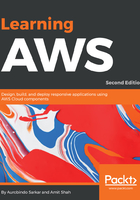
Amazon Relational Database Service (RDS)
Amazon Relational Database Service (RDS) provides an easy way to set up, operate, and scale a relational database in the cloud. Database options available from AWS include MySQL, Oracle, SQL Server, PostgreSQL, and Amazon Aurora. With RDS, you can launch a DB instance and get access to a full-featured MySQL database and not worry about managing or administering it. Amazon RDS can significantly reduce effort on common database administration tasks, such as backups and patch management.
Launching a database requires you to select a database engine, license type, an instance class, and storage capacity. The RDS instances are preconfigured for the DB instance you choose. It is equally easy to monitor and scale your database instance (for both compute and storage capacities).
For production-grade availability, you can choose the Multi-AZ deployment option. In Multi-AZ deployments Amazon RDS automatically creates a primary DB instance and then synchronously replicates the data to another instance located in a different availability zone. In this setup, the RDS can automatically failover to the standby instance. For consistent IOPS, you can choose SSD storage and provision IOPS as per your requirements.